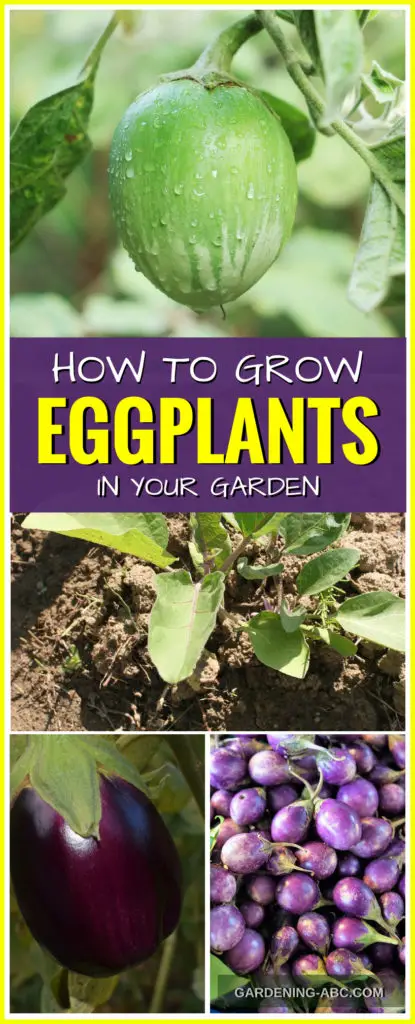We use affiliate links to run our site. When you buy through links on our site, we may earn an affiliate commission, without any added cost to you. Learn more
Have you ever tried growing eggplants at home, only to end up with a disappointing harvest? Don’t give up just yet! With the right knowledge and techniques, you can grow delicious eggplants right in your backyard.
As a seasoned gardener, I’m excited to share with you my proven methods for growing eggplants successfully. Get ready to learn everything you need to know, from choosing the right variety to harvesting your bountiful crop.
eggplant Variety: bush or vine
There are two types of eggplant plants: bush and vine. Bush eggplants are shorter and have a more compact growth habit, while vine eggplants are taller and have a more climbing or vining growth habit.
Both types of eggplant are typically grown as annuals in most gardens. Bush eggplants generally produce fruits that are smaller and more round than those of the vine eggplant.
are eggplants perennial?
The eggplant, Solanum melongena, is a member of the nightshade family. It is a perennial plant, meaning it can live for more than two years.
The eggplant is native to India and was introduced to China in the 14th century. It is now cultivated in warm climates all over the world.
The fruit of the eggplant is technically a berry, and it can be either white or purple in color.
How To Grow Eggplants
Scientific name: Solanum melongena
growing eggplant from seeds:
Starting eggplants from seeds is an economical way to grow these delicious vegetables. However, it can be a bit tricky to get the seeds to germinate successfully.
To give your eggplant seeds the best chance of sprouting, use seedling trays filled with a high-quality potting mix.
Keep the soil consistently moist, but not waterlogged, until the seeds have germinated.
You can also start your seeds indoors under grow lights or on a sunny windowsill to provide them with the warmth and light they need to thrive.
Once the seedlings have grown a few inches tall and have developed their first true leaves, transplant them into larger containers or directly into the garden.

how long do eggplants take to grow?
The average eggplant takes 50-70 days to mature. However, some varieties may take up to 100 days. The length of time also depends on the growing conditions, such as temperature and soil type. Generally, eggplants grown in warmer climates will mature faster than those in cooler climates.
Soil Temperature:
Eggplants require warm soil (70-75 degrees F), so if you live in a place where there is a problem with frost; start planting the seeds 2 months before the frosting date.
This will help the plants become strong enough and resistant to the external climate. Also, prepare some protection for the plants from frost.
Growing eggplants in Pots:
Eggplants can thrive in a variety of growing conditions. If you’re short on garden space or want to grow eggplants on your patio or balcony, using pots can be a great option.
When choosing a container for your eggplant, we recommend a 5-gallon pot for each plant to allow for proper root development.
However, not all eggplant varieties are well-suited for container gardening. Consider factors such as plant size, fruit production, and resistance to pests and diseases when selecting a variety.
Some popular eggplant varieties that perform well in containers include ‘Black Beauty’, ‘Fairy Tale’, and ‘Pingtung Long’.
When growing eggplants in containers, it’s important to provide them with regular water and nutrients. Use a high-quality potting mix, and fertilize regularly with a balanced, slow-release fertilizer. With proper care, you can enjoy a bountiful harvest of fresh eggplants from your container garden.
growing eggplant vertically
The eggplant is a tropical plant that is typically grown in the ground. However, it is possible to grow eggplant vertically.
To grow eggplant vertically, you have to train the plant to grow up. Supports like a trellis or fence work great for eggplants.
This has several benefits. First, it saves space in the garden. Second, it makes harvesting the fruit easier. Third, it can improve air circulation around the plant, which can reduce the risk of fungal diseases.
when to plant eggplant
The eggplant is a tropical plant that requires warm weather to grow. It is best to plant eggplant in late spring or early summer after the last frost has passed.
Start by sowing seeds indoors, at a depth of ¼ of an inch deep in flats or peat pots.
After the seeds germinate you can plant those seedlings outside.
how far apart should eggplant be planted?
When planting eggplant, space the plants 18 to 24 inches apart in the row, with 36 to 48 inches between rows.
While planting in beds, give at least 2 feet of space before planting another plant. A single mature eggplant can reach up to a height of 5 feet and generally forms short bushes.
This will allow the plants enough room to grow and produce a good yield of eggfruit.
The root system of An Eggplant:
The eggplant root system is fascinating and complex. The plant produces a deep, thick taproot that can reach up to 3 feet in length. This primary root quickly splits into several secondary roots, which anchor the plant in the soil and absorb water and nutrients.
The lateral root system is also dense and extensive, growing close to the surface of the soil.
Together, these two root systems give the eggplant a strong foundation that allows it to withstand high winds and heavy rains.
Soil for Eggplants
Eggplants are hardy vegetables that can tolerate various soil conditions, but they thrive in well-drained, loamy soils rich in organic matter.
Loamy soils are balanced mixtures of sand, silt, and clay particles that offer excellent drainage and moisture retention for plant hydration.
Soil pH:
Always perform a soil test to determine the ideal pH for your eggplant crop. The ideal pH for growing eggplants is 6.0-7.0. This range is optimal for the uptake of nutrients, especially nitrogen, and for water retention.
Soil that is too acidic or too alkaline can lead to nutrient deficiencies and poor plant growth.
Soil preparation:
To ensure your eggplants have the best chance of growing successfully, it is important to prepare your soil well in advance. This means tilling the soil, adding manure or compost, and ensuring that the pH level is correct.
Eggplants are sensitive to changes in pH levels. If the soil is too acidic or alkaline, eggplants will not be able to grow properly.
The soil preparation is almost the same as for the tomato plants. If you have not already read about tomato growing you can find them here.
How to Water Eggplants:
Eggplants are classified as semi-arid plants, meaning that they require less water than other plants. However, they still need a consistent supply of water to thrive.
Eggplants require about 1-2 inches of water per week, either from rainfall or irrigation. If the soil is too dry, the eggplants will wilt and the fruits will be small and misshapen.
Mulching is very important for eggplants if you are living in cooler areas of the planet. It not only provides protection against water loss, but it will also help the soil to remain warm.

the best fertilizer for eggplant:
While they don’t require a lot of fertilizer, using the right fertilizer will help your plants produce more fruit.
There are several types of fertilizer that can be used on eggplants. Compost is always a good choice for eggplants (or any plants, for that matter). It adds organic matter to the soil and helps retain moisture.
Aged manures are also a good option and provide nutrients that will help your plants grow. Apply manure before planting to give the nutrients time to break down.
You can also try foliar feeding (applying fertilizer to the leaves) to give your eggplants a boost. This method is especially helpful if your plants are starting to look yellow or unhealthy. Compost tea is a great foliar feed and you can easily make one at home.
Crop rotation is a good option if you are growing eggplants. Eggplants are generally attacked by aphids, mites, or caterpillars, the crop rotation process will definitely help to reduce pests.
do eggplants need support?
Eggplants are a type of nightshade plant and are related to tomatoes, potatoes, and peppers.
Eggplants need support because they are vining plants and can grow to be quite large. So if you don’t give the plant support the weight of the fruit can cause the plant to collapse.
Staking or cages are two of the most popular eggplant support structures. You can read more about it in this post.
Best companion plants for eggplants:
When choosing companion plants for your eggplants, only select plants that thrive in similar conditions.
Eggplants grow well with other vegetables in the Solanaceae family, like tomatoes and peppers. They also have a symbiotic relationship with beans and peas and legumes. They help to enrich the soil and provide support for the eggplant vines.
Other good companions for eggplants include spinach and marigold. Spinach is a cool-weather crop that can be planted alongside eggplants in the spring. Marigolds help to deter pests and improve the overall health of the garden.
More on companion planting can be found here.
Harvesting Eggplants:

After 3 to 4 months you can harvest the fruits. The best time to harvest is to pick them when they have reached 2/3 of their mature size.
If the eggplant matures fully and you are late in harvesting, the seeds will turn brown and will be bitter in taste. So it is always better to harvest them before they reached their optimal size.
Cut the fruit with a sharp knife from the woody stem.
The plants generally produce a lot of eggplants. If you have treated the plants properly, you should not be worried about the yield. Generally, 5 to 6 plants produce enough eggplants for the whole family to enjoy.
how big should eggplant be before picking?
When it comes to picking eggplants, size does matter. Eggplants that are too small may be bitter, while those that are too large may be seedy.
The ideal size of an eggplant can vary greatly, depending on the variety. However, most eggplants should be picked when they are about 6-8 inches in length or 2/3rd of their fully matured size.
Learning when to pick an eggplant correctly comes with practice, and you should be picking an eggplant like a pro after some time.
Eggplants are rich in vitamins B6, and K, and dietary fibers. It is also a good source of minerals such as potassium, Copper, and Manganese.
will eggplant survive the winter?
Eggplant is a tropical plant that is not frost-tolerant. In order to overwinter the plant, it is necessary to take measures to protect it from the cold.
One way to do this is to grow the plant in a pot and bring it indoors when the temperature starts to drop.
Alternatively, you can cover the plant with a frost blanket or tarp when cold weather is forecast and keep the plant protected.
how long do eggplant plants live
Although an Eggplant plant is a perennial, it is mostly grown as annuals. So in most cases, it lives for one growing season. In areas with mild winters, eggplant plants may be able to overwinter and produce fruit the following year.
In colder climates, the plants must be replanted each year. Eggplant plants typically take 60-90 days from planting to harvest.
If you live in a tropical climate, the plant may live for 2–3 years.
Conclusion:
Congratulations! Now you know everything you need to grow delicious eggplants in your garden or even in a pot. With the tips and tricks outlined in this post, you are well on your way to a bountiful harvest of this versatile vegetable.
But don’t stop here, explore our site for more tips and tricks on growing other vegetables, and share this post with your friends so they too can enjoy the benefits of homegrown eggplants.
Don’t wait any longer, start your eggplant-growing journey today and enjoy the fruits of your labor for years to come.
Remember to save this post for future reference by pinning it.

Amazon and the Amazon logo are trademarks of Amazon.com, Inc, or its affiliates.
